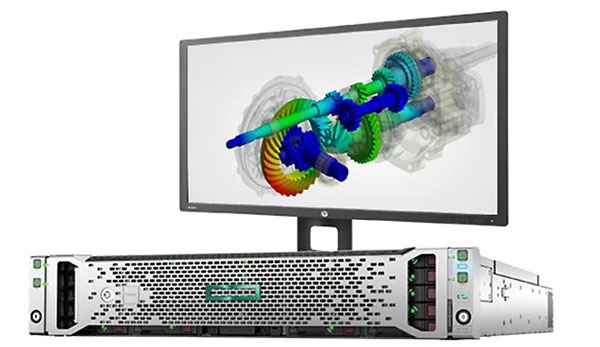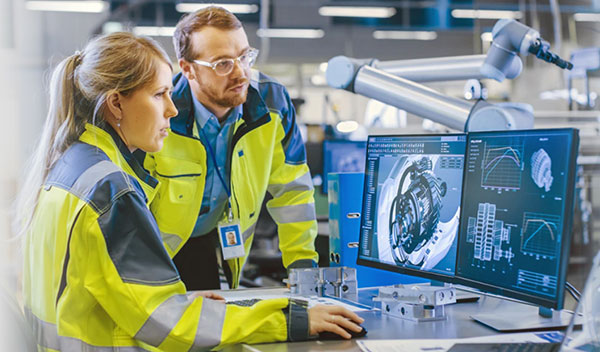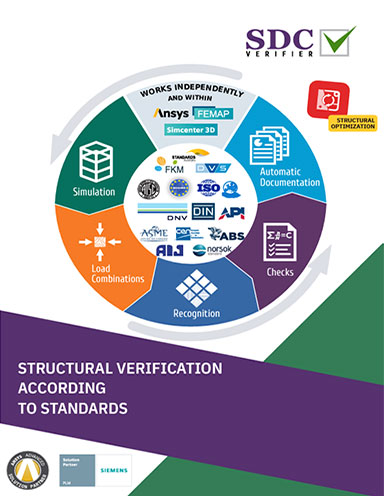
Deskside workstations are not the only option for empowering engineering simulation and visualization. HPE has partnered with Ansys for a preconfigured HPC, rack-mounted appliance that can be remotely managed. Image courtesy of Ansys.
Latest News
September 12, 2023
As engineering workloads increase in complexity, engineers are challenged with managing simulation and visualization tasks throughout the design cycle.
To meet these demands, engineering workstations must be carefully configured not only for CAD but also for computationally intensive simulations like computational fluid dynamics and finite element analysis. Engineers often run multiple applications simultaneously, making workstation optimization critical.
For anyone considering buying a new engineering workstation, eight key factors should be part of the evaluation process.
Key Factor 1: Sufficient Memory (RAM)
Large simulations or visualizations will run at a snail’s pace if there is not sufficient RAM for operations.
“Larger problems always benefit from scalable solutions using multicore [graphic processing units (GPUs)] or clusters,” says MingYao Ding, principal and vice president of Engineering at Ozen Inc., a consulting engineering firm based in Silicon Valley, CA.
Key Factor 2: Multi-Core CPUs
Many simulation tools scale linearly with more CPU cores, which substantially improve speed. CPUs are available with more cores than ever, mitigating previous limitations on computational bandwidth.
Engineers must balance core count and memory bandwidth; simply maximizing cores can negatively affect performance if memory bandwidth is constrained.
“Many engineers are also taking advantage of parametric and topology optimization these days. These techniques allow computers to discover the best design or trade-offs,” says Ding. “These techniques involve lots of analysis and can be run on multiple cores sequentially or concurrently across a single or multiple system[s]. These analyses will benefit from as much memory, CPU and GPU as you can find available.”
By itself, core count can be a misleading indicator of processing power for simulation, says Andy Ko, director of customer experience for Ansys.
“CAE workloads have both memory bandwidth and compute-intensive requirements that can vary for many reasons, including the dataset size and the solver used,” Ko says. “We have learned that a balanced hardware solution can provide engineers with the best return on their hardware and CAE software investment.
“In other words, engineers are better off investing in technologies that will accelerate their specific CAE applications,” Ko adds. “In this regard, selecting a CPU with the highest number of cores is usually not recommended because it can negatively affect memory bandwidth if the CPU memory isn’t increased along with the core count.”
Selecting enough memory (RAM) is key for most applications to solve “in-core” and to avoid paging to a hard drive (“out of core”), which is usually slow, Ko says. “In general, for Ansys Mechanical you want about 15 GB of RAM per million degrees of freedom (DOF); for Ansys CFX, Fluent, HFSS and Maxwell you want 8 GB of RAM per core.” Other popular solvers will have similar requirements.

GPU devices with significant double precision performance (FP64) and at least 16GB of on-card memory are also recommended to achieve meaningful acceleration for most simulations that use the GPU card.
Key Factor 3: GPU Computing
Ding and Ko emphasize the value of GPU computing for simulations.
“Most simulation tools can utilize multi-core GPUs or clusters to speed up the simulation of large problems,” says Ding. She adds that many name-brand CAE solutions are now natively GPU accelerated.
“In these cases, pairing a GPU with a large memory can result in orders of magnitude speed increases very cost effectively,” she says.
Ko adds that exponential GPU core growth allows unprecedented simulation complexity and speed. CAE vendors are rapidly increasing the number of simulation products that take advantage of GPU computing, further accelerating usage. Not only does this speed up engineering tasks, it also makes new design exploration possible.
Key Factor 4: Fast Data Storage
Simulations generate massive files. Solid-state drive (SSD) technology is much more efficient than legacy hard disc drives (HDD) for processing large files. Ko cautions that insufficient RAM requires paging to drives, significantly slowing performance: “Fast storage is critical.”
Key Factor 5: Parallel Processing
Parallel processing and multithreading play a vital role in shortening the simulation cycle. Optimizing simulation workloads across resources through parallelization improves performance. The leading CAE vendors work closely with workstation vendors to optimize mapping workloads to compute resources. It is a given that any new workstation you consider should be certified by your key CAE vendors; be sure to ask specifically about parallelization.
Licensing can be an issue with parallel processing. Some CAE independent software vendors offer high-performance computing (HPC) licensing solutions that cover parallel and parametric processing. The latter is of interest for simultaneous design exploration. Instead of using separate (and usually more expensive) solver licenses, HPC licenses can be used to conduct concurrent simulations of parametric variations.
Key Factor 6: Cloud Computing
Engineers need to look beyond individual workstations for more power and scalability. Containerization, virtualization, high-performance clusters and cloud computing allow better resource access.
“Traditionally, engineering workloads were primarily executed on the local engineering workstation,” notes Ansys’ Ko. “However, with robust computer networks and cloud computing, those workloads can be shared among other workstations, offloaded to an on-premises high-performance cluster, or even to a cloud environment. These increasing computing options make increasingly complex engineering workloads feasible. Engineers will always push the boundaries of what they can do with more complex engineering workloads—it is usually not the increasing complexity of the workloads that drive the hardware requirements, but the availability of the hardware that limits the workloads.”
Key Factor 7: Emerging Technologies
Ding and Ko urge engineers to prepare for emerging technologies like artificial intelligence (AI) and its subset machine language (ML), both of which are already improving engineering computing. Ko encourages specifically looking for GPU-based solvers and visualizations.
Key Factor 8: Cost vs. Performance
Ding says that “While higher performance enables better results, it may require more investment in hardware and licenses. Understanding cost versus performance trade-offs and working with partners is key for optimization.”
Where Price Fits In
Many buyers use price as a determining factor when evaluating workstations. This can be a trap that places value on the hardware instead of the engineer.
“With the increased use of automation, engineers are more reliant on having the computer perform increased tasks, freeing the engineer to focus on more increased value tasks,” says Ko. “While workstation cost should be considered, it should be done because the cost of an engineer is vastly more expensive than that of a workstation or computation system. You therefore want to free the engineer to perform high-value tasks (such as evaluating results and making decisions) wherever possible. This means providing the engineer with sufficient computational resources in a timely manner. The cost of a reasonable or higher-than-average performance workstation pales in comparison to the cost of the engineer’s time—only if that workstation or computer is used well and efficiently.”

Every Case Is Different
Configuring the right workstation for simulation and visualization tasks is essential to meet the growing demands of complex engineering workloads. Experts recommend focusing on crucial hardware components like CPUs, GPUs and RAM, as well as leveraging parallel processing and multithreading capabilities. The integration of emerging technologies including AI and ML can revolutionize engineering simulations, but only if they are given the necessary hardware support.
Network computing and cloud computing options also open up new possibilities for engineers to tackle advanced simulations and visualizations. Careful evaluation of hardware configurations will allow engineering teams to maximize performance and efficiency, enabling them to deliver high-quality products and innovations in a rapidly evolving engineering landscape.
More Ansys Coverage
Subscribe to our FREE magazine, FREE email newsletters or both!
Latest News
About the Author
Randall S. Newton is principal analyst at Consilia Vektor, covering engineering technology. He has been part of the computer graphics industry in a variety of roles since 1985.
Follow DERelated Topics





